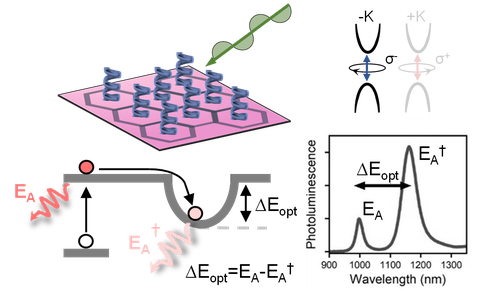Dr. Kevin Synnatschke
"Intercalation-Driven Optoelectronic Materials"
 © privat
© privat
Research Group Leader
NameMr Dr. Kevin Synnatschke
Send encrypted email via the SecureMail portal (for TUD external users only).
Visiting address:
Modular Gebäude, MOD 113 Stadtgutstr. 59
01217 Dresden
ORCID: 0000-0001-7018-9396
Google Scholar: Link
Contact Information:
Modulgebäude, Room 113
Stadtgutstr. 59, 01217 Dresden, Germany
Phone: +49 351 463 40541
Email:
WORK BIOGRAPHY
Kevin Synnatschke studied chemistry at Heidelberg University, obtaining his Bachelor’s degree in 2014 and his Master’s degree in 2017. From 2017 to 2021, he pursued his doctoral research in physical chemistry under the supervision of Prof. C. Backes at Heidelberg University. During this time, his work focused on developing versatile protocols for the exfoliation and characterization of van der Waals crystals and received several accolades for his work, including the Sophie Bernthsen Prize (2019), as well as two poster prizes at Flatlands Beyond Graphene (2018) and Chem2DMat (2019).
Following his PhD, he received a Walter Benjamin Postdoctoral Fellowship from the DFG, which allowed him to continue his research joining Prof. J. Coleman’s group at Trinity College Dublin from 2021 to 2023 focusing on the impact of morphology on the properties of liquid processed nanomaterial thin films. Afterward, he was awarded a DFG Return Fellowship, continuing his research at Technische Universität Dresden in the group of Prof. X. Feng.
Since June 2024, Kevin Synnatschke is leading his own research group as part of the Collaborative Research Centre (CRC) 1415 at TU Dresden with a project on morphology control in liquid deposited 2D nanomaterials. His current research activities include leveraging electrochemical intercalation strategies to illuminate mechanisms of intercalation to enhance exfoliation efficiency and to precisely tune the properties of nanomaterials for applications in optoelectronics and magneto-optical devices.
RESEARCH INTERESTS
Liquid Exfoliation and Large-Area Morphology Control of Novel 2D Materials
Our research addresses advancing liquid-phase exfoliation (LPE) methods to isolate novel 2D materials, including both, inorganic materials, such as HfTe2, NiPS3 and CrSBr with enhanced efficiency and precision. By testing different exfoliation protocols, we aim to overcome current limitations of LPE through innovative approaches such as the excitation of vibrational out of plane modes and electrochemical intercalation. These techniques are designed to improve exfoliation yield, and control over the nanomaterial aspect ratio, while providing new insights into the fundamental mechanisms governing LPE.
Complementing LPE, strong emphasis is on large-area morphology control of deposited nanomaterials. By combining techniques, such as spray coating and a Langmuir-type approach, we aim to achieve precise control over the morphology, layer thickness, and overlap area of deposited nanomaterials. This enables on-demand tailoring of 2D material-based thin films and heterostructures tailored to applications ranging from thin-film transistors, sensing technologies, and transparent conductive thin films to catalysis.
New Functions in Layered Materials through Voltage-driven Intercalation
The second area of our research explores how intercalation chemistry in van der Waals materials can be used to tailor their electronic, optical, and magnetic properties. By introducing organic molecules into the van der Waals gaps of selected 2D crystals, we weaken interlayer interactions, enabling precise control over structural and electronic behavior.
Key goals include modulating photoluminescence, exciton dynamics, and magnetic phases through intercalation. This includes using suitable, optically active molecules to adjust light-matter interactions, introduce chiroptical properties and targeting antiferromagnetic materials, such as metal thiophosphates to manipulate spin states.
Our work integrates electrochemical methods with micromechanically cleaved nanomaterials and advanced characterization to develop dynamic 2D nanomaterials for optoelectronics, spintronics, and quantum technologies.
Leveraging Inorganic/Organic 2D Heterostructures for Chemical Nanopatterning
The third research activity explores the use of inorganic/porous organic heterostructures with well-defined interfaces to achieve covalent defect patterning with functional groups. By introducing precise chemical modifications, we aim to tailor the optical properties of novel 2D materials, such as MoTe2, GaTe and InSe at the molecular level. This strategy allows us to introduce new functionalities, such as enhancing photoluminescence quantum yield through the creation of shallow traps that reduce non-radiative recombination.
This aims to control the optoelectronic properties of 2D materials by incorporating tailored functional groups to induce plasmonic or chiroptical effects. These modifications provide new materials suitable for conceptual applications, such as near-field or spin-filtering devices for advanced optoelectronic technologies.
Publications (5 selected)
- K. Synnatschke et al., "Layer-by-layer assembly yields thin graphene films with near theoretical conductivity" npj 2D materials and applications, 2025.
- K. Synnatschke et al., "Inert liquid exfoliation and Langmuir-type thin film processing of semimetallic metal diborides." ACS Nano, 2024.
- K. Synnatschke et al., "Sonication-assisted liquid exfoliation and size-dependent properties of magnetic 2D α-RuCl3." Journal of Physics D, 2023.
- K. Synnatschke et al., "Exfoliability, magnetism, and stability of metal thiophosphate nanosheets made in liquid medium." 2D Materials, 2023.
- K. Synnatschke et al., "Sonication-assisted liquid phase exfoliation of two-dimensional CrTe3 under inert conditions" Ultrasonics Sonochemistry, 2023


